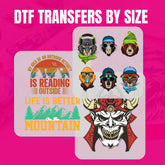DTF Transfers and Fabric Compatibility: What Works and What Doesn’t?
Will DTF Transfers Work on Any Fabric, or Do You Need Special Materials?
So you have your design, heat press and DTF transfer sheets ready to go. But then the big question hits: Can I put this on any fabric?
The short answer?
Yes, but with conditions. Unlike vinyl or screen printing, DTF transfers ready to press stick to a wide range of fabrics cotton, polyester, blends, even leather.
But before you go pressing everything in sight, let’s break down how different materials react.
Cotton Is The Safe for DTF Transfers
If you’re new to heat transfers, cotton is where you’ll feel most comfortable. It absorbs ink well and holds onto DTF transfer paper without issues.
• Natural fibers bond easily. The ink soaks in, creates a smooth finish.
• Bright color results. Since cotton holds pigment well, prints pop.
• No pre-treatment required. Just press, peel and you’re done.
Whether you’re working on hoodies, t-shirts or tote bags, custom gangsheet printing for cotton Apparel is a safe bet.

Polyester: A Trickier Surface with a Big Payoff
Synthetic fabrics can be finicky. Some repel ink, others overheat. But DTF transfer sheets work surprisingly well on polyester when done right.
• Lower heat settings help. Too much heat can melt the fibers, ruin the finish.
• Ink adhesion is strong. Unlike sublimation which requires light colors, DTF transfers wholesale work on dark polyester too.
• Perfect for sportswear. If you’re printing jerseys or athleisure gear, DTF transfer printer technology is better on polyester than traditional methods.
Press with caution and always test a sample before you run.
Blended Fabrics, The Middle Ground
Most apparel isn’t pure cotton or polyester—it’s a mix. 50/50 blends are common in sweatshirts, leggings, and casual wear. Luckily DTF transfers ready to press work on blended fabrics.
• Blends absorb ink like cotton but stretch like polyester.
• Results depend on the percentage. Higher polyester content means adjust heat and pressure.
• No need for pre-treatment. Unlike DTG printing which requires special prep for blends, heat transfers stick without extra steps.
If you print on a mix test heat settings to avoid scorching the fabric.
Leather: A Possible Option
Most people don’t associate DTF transfer sheets with leather but the results can be cool. Whether you’re branding custom iron patches or designing luxury bags, DTF can do the job.
• Lower temperature settings required. Too much heat damages the surface.
• Smooth textures hold transfers better. Genuine leather absorbs ink well, faux leather may need extra pressure.
• Test before mass production. Every leather type reacts differently so test first.
If done right DTF transfer printer technology is a bold alternative to embroidery or UV printing on leather goods.
What About Nylon, Spandex or Other Stretchy Fabrics?
Some materials heat up more than others. Nylon, Lycra and Spandex are heat sensitive and harder to print on. But DTF transfers wholesale suppliers now offer flexible films for stretchy fabrics.
• Lower heat reduces warping. A quick press at 280°F keeps the material intact.
• Extra stretch additives help. Some DTF transfer paper has special ingredients for elasticity.
• Use firm but not excessive pressure. A steady hand is key to a clean transfer.
These fabrics need extra care but with the right technique the print will hold without peeling.
What Fabrics to Avoid?
Not all surfaces work well with DTF transfers near me. Some just won’t stick or will warp under heat.
Waterproof materials. Coated fabrics won’t absorb ink.
Super heat-sensitive synthetics. Some plastics melt or warp at pressing temperatures.
Rough-textured textiles. Transfers need smooth surfaces to adhere evenly.
If unsure, always test a sample first.
How to Choose the Best DTF Transfers for Your Fabric?
A DTF transfer printer can print on almost any material, but knowing which type of film, adhesive and heat to use is key.
For cotton: Standard DTF transfer paper works great.
For polyester: Lower heat to prevent scorching.
For blends: Medium pressure for even adhesion.
For leather: Soft pressure and short duration.
For stretch fabrics: Flexible films to prevent cracking.
Choose the right transfer and you’ll make fewer mistakes, have better durability and happier customers.
Final Thought And Can You Use DTF on Anything?
Almost perfect! Though DTF transfer sheets are quite flexible, the fabric settings really make all the difference. Leather is bold; cotton is the easiest; polyester needs adjustments; mixtures work. Extra care is required of stretchy textiles; waterproof surfaces will not hold.
Knowing the proper technique for each fabric saves time, money, and aggravation if you are printing personalized clothing and wish for heat transfers that last.
Need DTF transfers wholesale that work on multiple fabrics? Check out dtftransferart.com for premium-quality custom gangsheet options, perfect for all kinds of prints.






